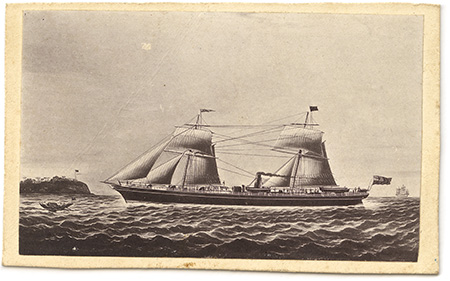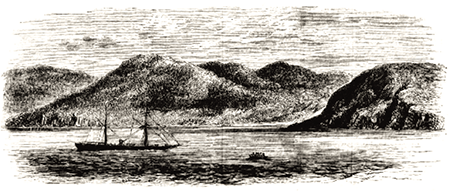Steamship ‘Normanby’
I have added a photograph of the RMS Normanby to my little stash of steamship carte-de-visite photos with accommodation plans on the back. The photo of the Normanby joins the ones of Hibernian and Denmark which I have already mentioned here.
The Normanby has a special interest for me because of its connection with Queensland, and the colonial government’s efforts to develop the northern shipping route that linked the colony to Asia and Europe through the Torres Strait. Before this route was opened, most ships from overseas arrived in Queensland only after calling at the southern colonies. The government built port facilities, dredged rivers, erected lighthouses, and offered profitable contracts to shipping companies to carry mail along this route.
The first of these contracts was awarded to the Eastern & Australian Mail Steam Co, a company formed in 1873 to operate a four-weekly mail and passenger service from Sydney to Brisbane, Batavia (now Jakarta), Singapore and Hong Kong. One of the first ships in the company’s fleet was the RMS Normanby, built in Glasgow and launched in 1874. The prefix RMS stood for Royal Mail Ship, a mark of quality and reliability.

When the newly-built Normanby arrived Queenslanders were keen to know about the ship, and its promise of faster communication with the old country. Local newspapers fanned that interest. Here is the Brisbane Courier’s description of the first and second-class passengers’ accommodation—see the plan on the back of the carte-de-visite, below:
Below, the accommodation is very comfortable. The saloon is aft, and of considerable length, with state rooms on both sides. The panelling is of varnished teak, picked out with white and gold, and looks very handsome. Over the tables punkahs are hung, so as to fan the passengers while at meals, but, as a matter of fact, during the voyage from Singapore hardly a meal was eaten below, the skylight lids on deck being made to project so as to admit of passengers sitting at them conveniently. On these the meals were served, and all the advantage of additional coolness and fresher breezes secured. There is a spacious ladies’ cabin with a bath-room and other conveniences attached, and a passage opening forward from the main saloon leads to a series of offices, including several bath-rooms, &c, an ice-room capable of storing about two tons, a surgery, lamp-room, steward’s pantry, mail-room &c. This passage eventually opens into the quarters for Chinese passengers, which occupy a complete section of the ship on the same level as the saloon, from side to side. A very neat arrangement permits of the berths here being built in a few minutes, or stowed away according to the number of passengers. The place is ventilated by a number of round port-holes, and is nice and airy but in these round openings are fitted in large square ports of great size, which can be opened in fine weather, and will make discomfort from confined air an impossibility. Further on, but only accessible from the deck, is the second cabin accommodation, also very airy and good, and opening from it is a cabin for females, stretching right across the width of the ship, and thus securing a thorough draught from the opposite port-holes. This is a capital cabin of its class, and will contain nine persons without invading a couple of sofa seats, which can, if necessary, be made into additional berths. There are separate cooking places for Europeans and Chinese. The former are served from a regular ship’s galley, whose door is a neat tesselated pavement, while the latter have a fireplace sheltered outwardly, but open to the deck near the bows. A very large staff of stewards, cooks, &c., are kept. These are for the most part Chinese, and appear a docile and very cleanly set of servants. The head steward and second steward are Europeans, The ship is steered from the bridge, which is well forward, so that the steersman can command a perfect view ahead. On the bridge, also, is a neat chart room, nicely fitted with cushioned seats, for the officers, and a very cool and breezy spot at all times. Double awnings protect the after-deck from the heat of the sun, being arranged like a tent and fly.
—from ‘The Torres Strait mail steamer Normanby’, Brisbane Courier, 14 December 1874
in 1877 the Normanby, steaming north, hit an uncharted rock near Pine Islet. The hull was damaged and the ship started to take in water. Immediate action by the captain and crew saved the ship, its passengers and crew. Here is the story as told by a Sydney newspaper:

The picture on the first page of our supplement shows the position of the steamship Normanby on Percy Island. This group is about sixty miles off the coast of Queensland, in about the latitude of Cape Palmerston. The steamer, on a northward trip, left Moreton Bay on August 11, at 10 p.m., immediately after receiving her mails. Made a good run to Keppel Bay, and, after a detention of two hours, resumed her passage thence at 10 a.m. on Monday, 13th. Had a light fair breeze all day, keeping up about ten knots. At half-past 9 p.m. she suddenly struck a rock. The pilot in charge being at his post on the bridge, Captain Reddell at once took command on deck, singing out, ‘Boat stations,’ and at once every officer and man was at his allotted station, the boat-falls were cleared and half lowered, and the momentary confusion ceased. Meanwhile, it having been found that the forehold had made four feet of water in some three minutes, the ship was steered at full speed directly for the nearest available beach, which was reached in about twenty minutes, the distance being about two miles. By the time she grounded on the beach the ship was very much down by the head from the weight of water accumulating in the fore compartments, and it would seem probable that on the rapid execution of this manoeuvre depended the safety of the ship and passengers, as in a short time more she would have refused to steer, the water would have burst into the engine-room, and the ship gone down by the head. However, having got her nose on the beach, the donkey-engine managed to pump the after-compartment clear of what water leaked through the joints of the fore-compartments, and the ship was in comparative safety for the time. The view in our supplement was sketched by Mr. B. Barker, and shows the position of the Normanby as seen from the steamship Brisbane. She was about one mile from the shore, her stern up clear, her head down. On the low foreshore of the island are the tents and huts of the crew and passengers. Above and beyond are a series of green hills partly covered with brushwood. Round the point to the right of the picture is a fine little creek.
—from ‘Stranding of the steamer Normanby’, Sydney Mail and New South Wales advertiser, 1 September 1877.
Nobody was hurt during this mishap. Temporary repairs were made and the ship was taken to Brisbane where a Marine Board enquiry decided that no blame is to be attributed to the master, but that on the other hand great credit is due to him for the energy he displayed and the methods he adopted to enable the vessel to be brought to this port in safety. Next, the Normanby was properly repaired in Sydney, at Mort’s Dock, and returned to service.
In 1880 the Normanby was sold to Catts Brothers of Singapore then, in 1892, to the Ocean Steamship Co and transferred to the Dutch flag. On 5 December 1896 the Normanby was wrecked near Pulau Bintang while on passage from Manila to Singapore.